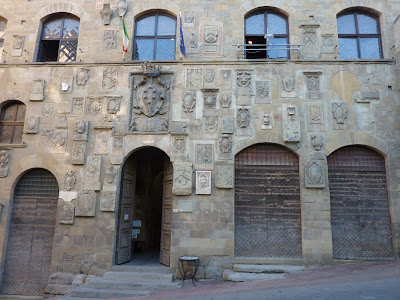 |
Among the abundant facilities and amenities, a
succession of scala mobili, escalators, takes
you from the parking lot up to the old city, in
the shade, too
|
 |
The very large mostly 13th-15th century duomo, to which
we'll return for some art and illumination
|
 |
Inside the Francesca, another vast but austere
Gothic church; we'll return in the next post for a
look at the frescoes that occupy most all of the
chancel
|
 |
Santa Maria della Pieva, 13th-15th century,
one view of the Romanesque facade and huge
campanile
|
 |
East side of Santa Maria della Pieve, which
fronts onto the Grande Piazza
|
 |
And the Grande Piazza
|
 |
The facade and campanile again; the latter with 40 bays
|
 |
Interior; another huge church
|
 |
Arezzo's public library, a beautiful old Renaissance palazzo
bearing the Medici coat of arms as well as many others
|
 |
Next door, Petrach's house, where they're
doing some remodeling
|
 |
House of Vasari, painter, architect, writer, Renaissance Man,
whose 1530 Lives of the Most Excellent Painters, Sculptors,
and Architects makes him, some say, the first art historian
|
 |
Interior of San Domenico, another 13th century Gothic
church, very austere, but home of Cimabue's Crucifix
|

No comments:
Post a Comment